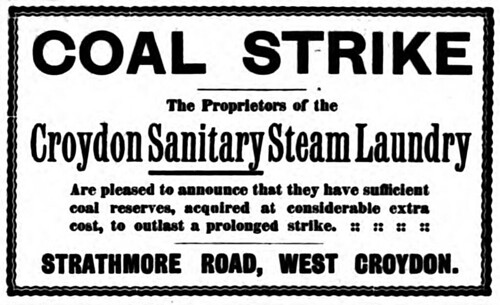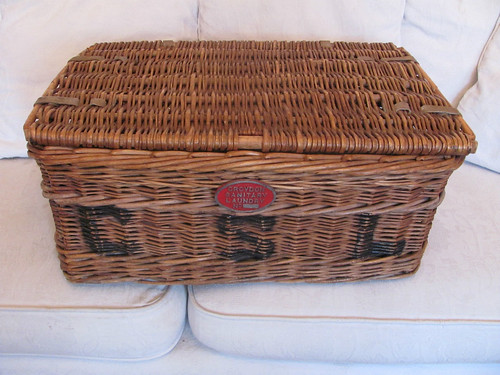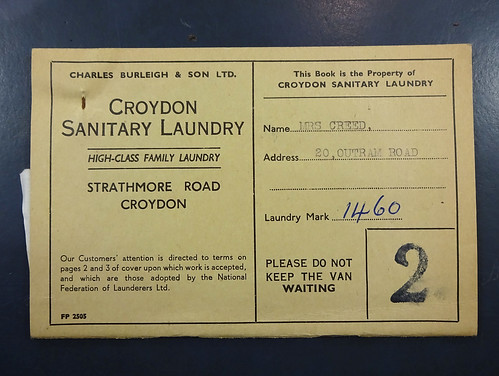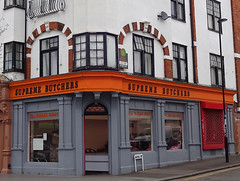224 London Road is home to Gucio Express, a Polish grocery shop operating under the Food Plus franchise.
1900s–1930s: The Croydon Sanitary Steam Laundry
Like its neighbours on both sides, number 224 was built shortly after the start of the 20th century as part of Royal Parade, a row of 26 shops with flats above. By the end of 1902, construction was complete and around two-thirds of the new commercial properties were occupied. However, despite some evidence of short-term use by auctioneers Stuart Baker & Co around 1904, 224 London Road had to wait until 1906 for its first long-term occupant. The wait seems to have been worth it, as said occupant was to remain here for the next three decades.[1]
The Croydon Sanitary Steam Laundry was an appropriate occupant for this relatively new development, as it had itself been set up just a couple of years before Royal Parade was completed, in similarly newly built premises on Strathmore Road. Its proprietor, Charles Burleigh, had a laundry receiving depot at 204 London Road by early 1902, and by the end of 1906 this had moved up the road to number 224 — then known as 6 Royal Parade.[2]

Charles seems to have been extremely proud of his laundry, claiming in advertisements that it was the “Most Successful Laundry in the South of England”, employing only the “Most Superior Class of Workers” and “doing the work of the principal families in the district”. He also emphasised the individual nature of the management, stating that the business was “personally managed by [...him] and his daughter” and “not a company affair”.[3]
It’s not clear how much of the laundry’s work came in via depots like the one on London Road; some of it, at least, was collected from customers’ homes by handcart.[4] Aside from handcart-pushers, Charles employed ironers, packers, sorters, and “callender girls”. The job of the latter was to operate calendering machines, which used heat and pressure to produce specific effects on the surface of fabrics, such as texturing or increased lustre. Although these effects would originally have been applied by the fabric’s manufacturer, they did not always survive the washing process, which perhaps explains why Charles offered the option of reapplying them.[5]


The depot remained at 224 London Road until at least the late 1930s, and the main laundry premises continued to operate on Strathmore Road until the early 1960s (albeit with a slight name change to the Croydon Sanitary Laundry along the way).[6]
1940s–1970s: Sport Craft
The next occupant of 224 London Road was also a long-term one, again remaining for around three decades.

Toy and model shop Sport Craft was open by late 1946, offering kits, books, plans, sets, accessories, and materials to “Turn Leisure Time to Pleasure Time”.[7]
Its proprietor, Alan Godfrey, was born in Thornton Heath in 1922. The son of a coal merchant, Alan attended the Stanley Technical School for Boys in South Norwood and had an interest in mechanical matters including amateur electroplating and the construction of model planes from balsa wood.
He started out in business by selling models from his father Lewis’s coal store a little further down the road at number 192, and later returned this favour by taking orders at his shop for his father’s coal.[8]
Mike Etheridge, who visited Sport Craft as a nine-year-old in the 1950s, remembered the experience:[9]
I first visited the shop to buy my first rubber powered aircraft kit, a Fairy Firefly. I was accompanied by my older brother Ron who served an apprenticeship with the Hawker Aircraft company at Kingston, so he was well qualified to help me build the plane [...]
The memory I have of the shop is that it had a narrow frontage but had a fairly extensive interior and may have had an island bench arrangement you could walk around. It was on this bench that I found the Firefly kit. Visiting the shop was magical for me and encouraged me and my friends to pursue the hobby. Eventually the three of us progressed with our models so at the age of 12 we built model planes with diesel engine power that we flew at Epsom Downs.
Alan’s son David also remembered Sport Craft:[11]
[...] the shop opened every day but Sunday. In the week dad would cycle home and back at lunchtime. On Saturday — traditionally busier — both mum and dad would man the shop, while we were babysat by grand parents. If we went away in the summer, which was quiet, my grandmother would mind the shop during the week and my father would go home by train at the weekend to deal with the Saturdays.
When we were older the whole family spent days at the shop, lurking in the room at the back with the sofa and gas fire. [...] Also in the back was my fathers green desk and files, as well as an old gas cooker used for the inevitable cups of tea. [...] Generally I was sent down to the bakery in the next block to buy iced buns. Somehow this is still my idea of a real treat.
As well as the usual toys it sold a large collection of plastic kits, balsa wood kits and Triang model trains. At one point I believe he had also sold ammunition – this is why there were such good bars on the back window – but this ceased long before I was paying attention.
Whilst generally I was just a “spectator” in the shop occasionally I would serve customers. This meant ringing up the total using the old silver “National” cash register, and giving change. This got much easier after decimalisation, when prices ceased finishing “19/11d” (pronounced 19 shillings and elevenpence), and ended “...99p” instead. [...]
Of course the advent of decimalisation also meant that the arithmetic on the old cash register ceased working usefully. Typically ingeniously Alan attempted to modify it, using Araldite to fill in some of the ratchet positions to reduce them from 12 to 10 steps. Perhaps unsurprisingly this was unsuccessful, and subsequent arithmetic was done by hand.
Changes over the years included not only the consequences of decimalisation, as described above, but also the advent of self-service:[12]
One significant change occurred in the 60’s–70s. Previously, like all other shops, the goods and the customers were kept separate. Shops had a collection of glass fronted cabinets, and one would ask the assistant if you could look at an item. Slowly this turned over to self-service, less costs for staff, more difficulties with shoplifting. Alan slowly retired the cabinets and created yards of white painted shelves to display items.
Alan continued to operate Sport Craft until the mid-1970s, but was forced to close the shop for good after the freeholder insisted on expensive repairs and rewiring that Alan found impossible to afford. Although Croydon Council allowed a certain period of relief on business rates for empty properties, which helped the family finances for a while, Alan was unable to sell the lease before this period ran out. Needing to make ends meet, he started using the premises to run a clothing consignment store:[13]
Basically this was a second hand clothing store where the stock mostly came from people bringing in clothes to sell. They would get a percentage of the money if they sold. This was supplemented by my parents doing a round of jumble sales on Saturdays, and bringing the spoils home to wash. On these we got to keep the complete sale price. It was surprising how well this business worked.
The clothing store lasted for more than a year, but eventually closed in its turn.[14]
1970s–2010s: Amalgamation with number 222; National Westminster Bank, a series of restaurants, and Lobo Halal Meat
The departure of the Godfreys signalled an significant change for 224 London Road. The National Westminster Bank, which had occupied the next-door corner property at number 222 since the early 1920s and bought the freehold of both 222 and 224 in 1965, was now able to expand into the newly-vacant 224. After gaining planning permission from Croydon Council, the bank converted the two properties into one and continued to operate from the double-sized premises until August 1994.
A couple of years of vacancy followed the departure of the bank, during which several planning applications were lodged with Croydon Council and building work took place to convert the premises into a restaurant. The first decade of the 21st century saw 222–224 London Road occupied by a string of short-lived restaurants: Viet Hoa, Tasty House, Savana, and Humming Bird. All were gone by the end of 2009, and by January 2012 the premises had been once more converted, this time to a butchers shop called Lobo Halal Meat.[16]

2010s: Division from number 222, and a Polish grocery shop
Around the mid-2010s, numbers 222 and 224 were separated into two properties again. Number 222 continued as a halal butcher, albeit under new management and the new name of Supreme Butchers.
Number 224 became a Polish grocery shop. This was open by October 2016 under the name of Polish Deli Gucio, but changed its name shortly afterwards to Gucio Express. By July 2018 it was operating as a franchise of Food Plus, a Polish network with shops in England, Scotland, Wales, Germany, and the Netherlands.[17]
When the spread of Covid-19 to the UK led to a government-imposed lockdown in March 2020, all shops other than those selling essential goods were instructed to close. However, food shops such as Gucio Express were permitted to continue trading. On 26 March, the cover photo on its Facebook page was changed to inform customers of the new precautions required when shopping there: card payments only, disposable gloves for picking up bread and vegetables, keeping a “safe distance” from staff and other customers, and no more than five customers at a time.
Thanks to: David Godfrey and N M Godfrey; Henry Braun; Lis Watkins; Mike Etheridge; Mitchantiques; Sophie Volker and Kim Harsley at the RBS archives; the Planning Technical Support Team at Croydon Council; the staff, volunteers, and patrons at the Museum of Croydon; and my beta-readers Fred and Kat. Monetary conversions performed using the Bank of England inflation calculator (prices < £100 given to the nearest penny, prices from £100 to < £100,000 to the nearest pound, prices from £100,000 to < £1 million to the nearest £1,000, prices from £1 million to < £100 million to the nearest £100,000, prices ≥ £100 million to the nearest million).
Footnotes and references
- Ward’s directories list “building land” in 1901, “nine shops building” in 1902, “Unoccupied” from 1903 to 1906 inclusive, “Croy. Sanitary Steam Laundry Depot” from 1907 to 1932 inclusive, “Croydon San. Steam Laundry Depot” in 1934, and “Croydon San Laundry Depot” in 1937 and 1939 (the final edition). (Note that the “nine shops building” in 1902 are just the ones between Nova Road and Hathaway Road; those south of Nova Road and north of Hathaway Road are summarised separately).
- Ward’s directories list a “Croydon Sanitary Steam Laundry Depot” at 72 London Road (later renumbered to 204) from 1902 to 1906 inclusive, at 6 Royal Parade from 1907 to 1927 inclusive, and at 224 London Road from 1928 to the final edition in 1939 (albeit as the slightly abbreviated “Croydon San. Laundry Depot” in 1937 and 1939). These directories also list the Croydon Sanitary Steam Laundry itself on the south side of Strathmore Road from 1899 onwards. A letter from Charles Burleigh to the editor of the Croydon Guardian, published on page 2 of the 14 February 1903 edition, states that he “built the Croydon Sanitary Steam Laundry and commenced business four years ago.” See the footnotes of my article on 204 London Road for evidence supporting Charles’ assertion that he built (or at least caused to have built) the laundry premises himself.
- Quotations are taken from two adverts placed in the Croydon Guardian; one on page 8 of the 28 July 1900 edition and the other on page 8 of the 30 November 1901 edition.
- An article on page 12 of the 10 June 1911 Croydon Guardian (“Washing in the road”) reports that 16-year-old Charles William Newing had been brought before the magistrates for “embezzling” from the Croydon Sanitary Steam Laundry, which had employed him “to collect washing in a hand cart and give receipts for all money received.” The total amount of money “not accounted for” was £1 7s 10d (£165 in 2019 prices). The laundry’s lawyer explained that his clients “were reluctant to bring the boy to Court, but they felt bound to do so because after he was discharged he went round to customers and continued collecting money, whilst the washing he received he threw about the road.” The magistrates sentenced the miscreant to 12 months’ probation.
- An advert for staff on page 4 of the 18 January 1902 Croydon Guardian lists positions for “Callender [sic] girls” as well as “good piecework IRONERS and experienced PACKERS and SORTERS.” Information on calendering is taken from Textiles, Paul H Nystrom, 1933, Appleton-Century (pages 274–276).
As stated in an earlier footnote, Ward’s directories continue to list the depot at 224 London Road until the final edition in 1939. Phone books list the Croydon Sanitary Laundry on Strathmore Road up to and including the August 1960 Outer London: Kent/Surrey edition, but not the December 1961 edition.
It’s unclear why the laundry itself finally closed. Although the latter half of the 20th century saw widespread adoption of the automatic washing machine in the home, this came rather later than the 1960s; as of 1969, only 5% of British households had such a machine (“Dirty linen: women, class, and washing machines, 1920s–1960s”, Christine Zmroczek, 1992, Women’s Studies International Forum 15(2), 173–185). One reason may have been the redevelopment of Strathmore Road; as can be seen on the National Library of Scotland side-by-side comparison of the 1953–4 Ordnance Survey map with OpenStreetMap today, the part of Strathmore Road once occupied by the laundry is no longer there. Henry Braun, who knows more about architecture than me (but insists he is no expert), tells me that the houses in the Google Street View link I sent him are definitely in “the 1960s-ish style” (via email, 26 March 2020), making it quite plausible that the laundry was demolished to make way for housing.
- Evidence that Sport Craft was open by the end of 1946 comes from an advert on page 11 of the 20 December 1946 Croydon Advertiser, reproduced here. The list of stock and quotation about “Pleasure Time” are also taken from this advert.
- Background information on Alan Godfrey was provided by his son David (via email, 31 March 2020). Information on Alan’s selling models from Lewis’s store also comes from David (via email, 8 November 2019): “I know that my father had started off selling items – the models I think – in his fathers coal store in the next block.” For evidence on the use of number 224 as a “Coal Order Office” for L F Godfrey, see the 1950s photo reproduced here.
- Via messages on the Model Flying forum, 7 and 8 April 2020.
- Note the posters advertising Annie Get Your Gun; David points out that this film came out in 1950.
- Via email, 8 November 2019 (paragraph 3) and 31 March 2020 (all the rest). I have corrected one minor typo.
- Quotation from David Godfrey (via email, 31 March 2020).
- Croydon phone books list “Sport-Craft” at 224 London Road up to and including the January 1976 edition. According to a poster on the Model Flying forums, Sport Craft closed “by 1976” (Mike Etheridge 1, “How far do you travel to the nearest decent model shop?”, page 3 at 16/02/2015 23:39:52 and page 4 at 19/02/2015 12:42:00). All other information, and the quotation below, from David Godfrey (via email, 31 March and 22 April 2020).
- Information on length of clothing store tenure provided by David Godfrey (via email, 31 March 2020).
- Downloading or copying this image for use by third parties or end users is strictly prohibited by RBS Archives, except for private study.
- For evidence on all this and many more details, see my article on 222 London Road.
- All information about the division of the premises and Polish Deli Gucio/Gucio Express is from personal observation. Information about Food Plus is taken from the front page of its website (accessed 26 March 2020).
- Normally I end my articles with a photo of something I’ve bought from the current occupant of the premises, but given my dodgy lungs leaving the house right now is not particularly wise, and unfortunately the only thing I’ve ever bought from Gucio Express was a pot of sour cream that I didn’t think I needed to take a photo of.

